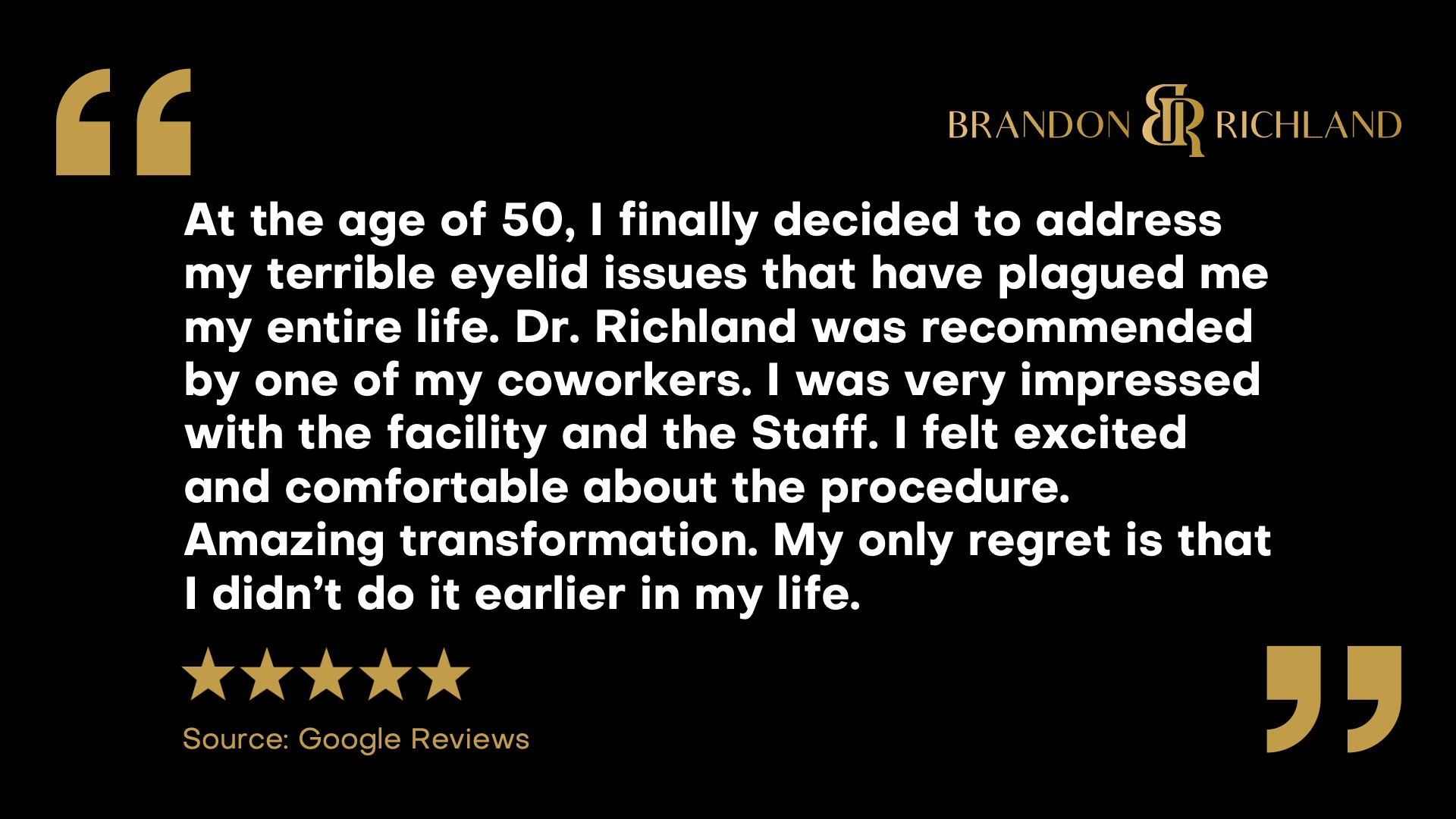Published by Dr. Brandon Richland, MD

“At the age of 50, I finally decided to address my terrible eyelid issues that have plagued me my entire life. Dr. Richland was recommended by one of my coworkers. I was very impressed with the facility and the Staff. I felt excited and comfortable about the procedure. Amazing transformation. My only regret is that I didn’t do it earlier in my life.”
Read the full Google Review here.
Understanding Eyelid Surgery
Eyelid surgery, also known as blepharoplasty, is a procedure that can enhance the appearance of the eyelids. It can address typical concerns such as sagging skin, wrinkles, and puffiness.
What Is Blepharoplasty?
Blepharoplasty is a surgical procedure aimed at correcting aesthetic or functional issues with the eyelids. It involves the removal or repositioning of skin, muscle, and sometimes fat to rejuvenate the periocular area. The surgery can be performed on the upper lids, lower lids, or both.
Types of Eyelid Surgeries
- Cosmetic Blepharoplasty: Primarily improves the appearance of the eyelids, focusing on reducing bags, wrinkles, and sagging skin.
- Functional Blepharoplasty: This is aimed at eliminating vision obstruction due to droopy eyelids and improving eye function.
The choice between these types depends on the patient’s objectives and medical needs.
Benefits of Eyelid Surgery
Enhanced Vision: For those whose eyelids interfere with their sight, blepharoplasty can remove the obstruction, leading to better vision.
Improved Appearance: Surgery can help create a more youthful and rested look by addressing concerns like puffiness or droopiness.
Boost in Self-confidence: The aesthetic improvements can significantly enhance an individual’s self-esteem and body image.
Preparation and Procedure
This section walks through the necessary steps and details of eyelid surgery, from the initial consultation to the type of anesthesia used.
Initial Consultation and Examination
The journey to eyelid surgery begins with a thorough initial consultation. Here, the surgeon evaluates the patient’s medical history, conducts a detailed examination of the eyelids, and discusses the patient’s goals and concerns. Assessing the skin quality and the distribution of fat and muscles around the eyes informs the surgical plan. Patients are advised to have realistic expectations and a clear understanding of the potential outcomes.
The Surgical Process
During the surgical process, precision is key. An expert surgeon makes careful incisions along the natural lines of the eyelids, the creases of the upper eyelids and just below the lashes or inside the lower eyelid. This approach minimizes visible scarring. Excess fat, muscle, and loose skin are then removed or repositioned to create a more youthful and rested appearance. Once the reshaping is complete, the surgeon closes the incisions with fine sutures.
Steps of Surgery
Incision Placement
Description: Incisions are strategically placed in the eyelid’s natural crease or inside the lower eyelid.
Tissue Modification
Description: Surplus fat, muscle, and skin are excised or adjusted.
Incision Closure
Description: Incisions are meticulously sutured to promote minimal scarring.
Types of Anesthesia Used
The selection of anesthesia is a critical part of the surgery. The two primary types utilized are:
- Local Anesthesia: Typically paired with sedation, it numbs the eyelid region while the patient remains awake but relaxed.
- General Anesthesia: The patient is put to sleep for the duration of the procedure. This is often used for more extensive or concurrent procedures.
The choice between local or general anesthesia is determined based on the patient’s needs, the extent of the procedure, and the surgeon’s recommendation. The patient’s safety and comfort are the utmost priority.
Anesthesia Type
Local Anesthesia
Usage: Numbs targeted area; patient is awake but sedated.
General Anesthesia
Usage: Patient is asleep; used for longer or more complex surgeries.
Each step of the process, from preparation to the surgical method and anesthetic choice, is handled with care to ensure the best outcomes and patient satisfaction.
Recovery and Aftercare
Following eyelid surgery, patients typically experience a recovery period that involves swelling, bruising, and the application of medications and ointments. Adherence to aftercare instructions is crucial for managing pain, ensuring proper healing of incisions, and reducing the risk of complications.
Post-Surgery Recovery Timeline
Immediate Post-Operative Period (Day 1 to Day 7):
- Swelling and Bruising: Most pronounced during the first 48 hours post-surgery and gradually subsides over the week.
- Medications: Pain can be managed with prescribed medications.
First Week:
- Stitches: If non-dissolvable stitches are used, they are typically removed within the first week.
- Activities: Limit strenuous activities to reduce risk of bleeding or swelling.
Weeks 2 to 4:
- Monitoring: Patients should observe the healing process, as the majority of swelling and bruising diminishes.
Months 1 to 6:
- Gradual improvement continues, with scars becoming less noticeable.
Possible Complications and Management
- Infection and Bleeding: Can be minimized with proper wound care and cleanliness.
- Scarring: Typically, scars fade over time; however, abnormal scars may be managed with additional treatments.
- Dry Eyes: Can be alleviated with lubricating ointment or eyedrops.
- Delayed Healing: Follow-up with the surgeon is necessary to address and manage any complications.
Management strategies should be discussed with a board-certified plastic surgeon and personalized based on the individual risk factors and the specific procedures performed.
Long-Term Care for Best Results
- Sun Protection: Use sunglasses to protect healing incisions from UV rays.
- Incision Care: Long-term use of scar-minimizing treatments may be recommended.
- Follow-Up: Regular follow-up appointments with the surgeon are essential to monitor progress.
A focus on gentle care and protection of the eyes can facilitate optimal long-term outcomes and minimize the chances of permanent negative effects such as conspicuous scarring.
Schedule Your First-Class Cosmetic Consultation with Dr. Brandon Richland, MD
Contact Dr. Richland today by visiting RichlandMD.com, scheduling a cosmetic consultation, or by calling 714-844-0398 or 949-997-2958 directly.











